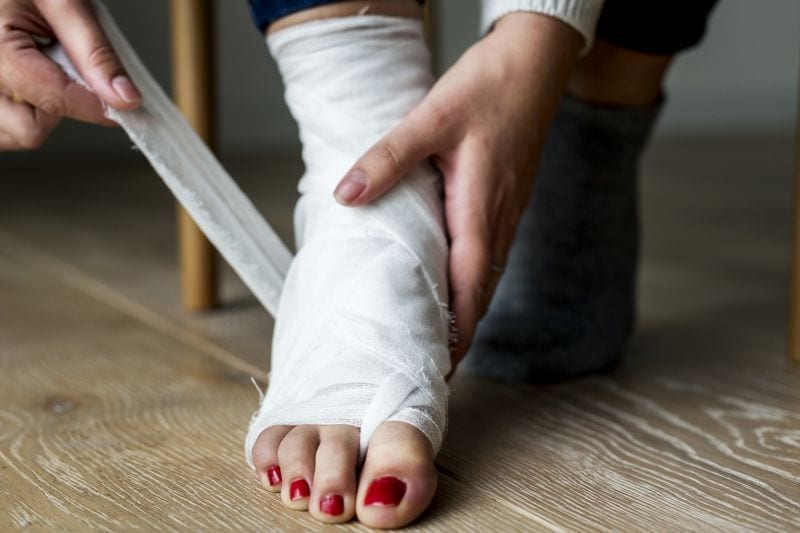An estimated 25,000 Americans suffer from an ankle sprain each day according to research from the American College of Sports Medicine. Although many times these sprains occur during athletics, ankle sprains can also occur during daily activities like walking across a lawn and going up or down stairs. The recovery time for the majority of ankle sprains is 4-8 weeks, but tissue remodeling and nerve deficits can be detected for up to 1 year post injury. Often, these sprains require medical attention and can benefit from physical therapy to promote tissue healing, restore joint bio-mechanics, strength and balance.
Here are some of the ways you can prevent ankle sprains:
1. Balance Yourself
One way to avoid ankle sprains is to improve your balance. In order to do so, you should understand how balance works within your body. For starters, your sight impacts balance because your body moves based on anticipation, experience and expectations from what it sees. Without your eyes, your body uses its ability to sense where you are in space, which is called proprioception.
There are 45 miles of nervous tissue running throughout your body. These nerves also help you maintain balance. For example, the nerves in your foot and ankle help you sense the surface you’re walking, running, or jumping on. Your third sense of balance is something is something called the vestibular system, which is work of the inner ear telling you you’re moving, spinning, falling or some other change in body position. You are likely in good shape when all three of these balance systems are working together.
Fortunately, there are ways to improve your balance, which can help prevent injuries. One way to do this is by practicing balancing on one foot when brushing your teeth or performing light upper body exercise. The nerves in your foot and ankle will continue to adjust and train the surrounding muscles in your ankle/leg/hip and even lumbar stabilizers to activate and control your movements. Physical therapy can also help to improve more serious balance issues andor vestibular conditions.
2. Strengthen Your Core
The strength and function of your hips and trunk is important to how you move. Imagine running lightly and abruptly changing direction. If you lack strength in your core, your body will likely keep moving due to an absence of hip control. With your body weight pushing past what your foot and ankle can control, the end result could be a rolled ankle and/or fall. This is why it is important to pay attention to hip and abdominal/back strengthening during workouts.
3. Build Up Ankle Strength
Building up ankle strength is a great preventative technique. This can be done with single leg strengthening exercises like squats, lunges, dips and rubber band strengthening workouts. A stronger base will make it easier to stay on your feet and control change in body position.
4. Improve Flexibility
A balance between strength and flexibility is important. Simple stretching for 30-60 seconds after a light warm-up can help relieve discomfort and promote adequate mobility of the lower leg. Ligament or joint hypermobility is a symptom of an ankle sprain, so stretching should be performed carefully and comfortably.
5. Progressive Activity
It is not a good idea to hike several miles out of the blue without preparing your body. If you know you have a new sports season or activity coming up, it is a good idea to get your body ready. This doesn’t mean full body training, but rather getting into the habit of regular exercise and mimicking your desired activity. Since muscle memory is a factor in ankle sprains, practicing the movement or sport you are participating in can help prevent injury.
6. Brace for It
Don’t hesitate to use a brace or tape your ankle in order to prevent injury. This could be the difference in maintaining health, as braces and taping add support. Also, bracing promotes feedback to your body so you respect the ankle when performing your desired activity.
7. Dealing with Ankle Injuries
Overall, the role of the ankle is to adapt to variable ground interactions and provide the leg an advantage when walking great distances. Ankle sprains can happen to people of all ages, but is most common in the teenage years to mid-30s and can be recurrent throughout life. In one study, more than 70 percent of people with ankle sprains reported having issues 18 months out from injury. If you are struggling with an ankle sprain, visit a medical professional who specializes in foot and ankle injuries for a complimentary injury screening to help determine course of action.
When Surgery becomes Necessary
Oftentimes ankle injuries are so severe that they will require surgery. Ankle injuries can vary from minor sprains to serious fractures, in which case surgical intervention may be necessary. Trauma to the foot or ankle can negatively affect a person’s daily activities and overall body function can be limited. In response, performing physical activities can be near impossible or at the very least, very painful. That is why surgery in some cases may be the only viable option to regain full motor function of your foot or ankle.






